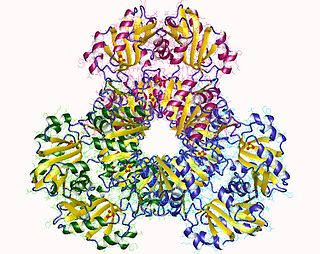
The cephalosporins are a class of β-lactam antibiotics originally derived from the fungus Acremonium, which was previously known as Cephalosporium.
4-Hydroxybenzoic acid, also known as p-hydroxybenzoic acid (PHBA), is a monohydroxybenzoic acid, a phenolic derivative of benzoic acid. It is a white crystalline solid that is slightly soluble in water and chloroform but more soluble in polar organic solvents such as alcohols and acetone. 4-Hydroxybenzoic acid is primarily known as the basis for the preparation of its esters, known as parabens, which are used as preservatives in cosmetics and some ophthalmic solutions. It is isomeric with 2-hydroxybenzoic acid, known as salicylic acid, a precursor to aspirin, and with 3-hydroxybenzoic acid.

Ribose-phosphate diphosphokinase is an enzyme that converts ribose 5-phosphate into phosphoribosyl pyrophosphate (PRPP). It is classified under EC 2.7.6.1.
In enzymology, an alkane 1-monooxygenase (EC 1.14.15.3) is an enzyme that catalyzes the chemical reactions

The enzyme methionine γ-lyase (EC 4.4.1.11, MGL) is in the γ-family of PLP-dependent enzymes. It degrades sulfur-containing amino acids to α-keto acids, ammonia, and thiols:
In enzymology, an aliphatic aldoxime dehydratase (EC 4.99.1.5) is an enzyme that catalyzes the chemical reaction
In enzymology, a 4-chlorobenzoyl-CoA dehalogenase (EC 3.8.1.7) is an enzyme that catalyzes the chemical reaction
In enzymology, a glutarate—CoA ligase is an enzyme that catalyzes the chemical reaction
In enzymology, a protein-secreting ATPase (EC 3.6.3.50) is an enzyme that catalyzes the chemical reaction
The enzyme 4-hydroxybenzoyl-CoA thioesterase (EC 3.1.2.23) catalyzes the reaction
Poly(3-hydroxybutyrate) depolymerase (EC 3.1.1.75, PHB depolymerase, systematic name poly[(R)-3-hydroxybutanoate] hydrolase) is an enzyme used in the degradation processes of a natural polyester poly(3-hydroxyburate). This enzyme has growing commercialization interests due to it implications in biodegradable plastic decomposition.

In enzymology, an agmatinase (EC 3.5.3.11) is an enzyme that catalyzes the chemical reaction

In enzymology, an amidase (EC 3.5.1.4, acylamidase, acylase (misleading), amidohydrolase (ambiguous), deaminase (ambiguous), fatty acylamidase, N-acetylaminohydrolase (ambiguous)) is an enzyme that catalyzes the hydrolysis of an amide. In this way, the two substrates of this enzyme are an amide and H2O, whereas its two products are monocarboxylate and NH3.
In enzymology, a guanidinoacetase (EC 3.5.3.2) is an enzyme that catalyzes the chemical reaction
In enzymology, a cephalosporin-C transaminase is an enzyme that catalyzes the chemical reaction

7-ACA is the core chemical structure for the synthesis of cephalosporin antibiotics and intermediates. It can be obtained by chemoenzymatic hydrolysis of cephalosporin C.
Acyl-homoserine-lactone acylase (EC 3.5.1.97, acyl-homoserine lactone acylase, AHL-acylase, AiiD, N-acyl-homoserine lactone acylase, PA2385 protein, quorum-quenching AHL acylase, quorum-quenching enzyme, PvdQ, QuiP) is an enzyme with systematic name N-acyl-L-homoserine-lactone amidohydrolase. This enzyme functions as a quorum quencher by catalysing the following chemical reaction
(R)-amidase (EC 3.5.1.100, R-stereospecific amidase, R-amidase) is an enzyme with systematic name (R)-piperazine-2-carboxamide amidohydrolase. This enzyme catalyses the following chemical reaction
3-Fumarylpyruvate hydrolase (EC 3.7.1.20, nagK (gene), naaD (gene)) is an enzyme with systematic name 3-fumarylpyruvate hydrolyase. This enzyme catalyses the following chemical reaction
2-haloacid dehalogenase (configuration-inverting) (EC 3.8.1.10, 2-haloalkanoic acid dehalogenase, 2-haloalkanoid acid halidohydrolase, DL-2-haloacid dehalogenase, DL-2-haloacid dehalogenase (inversion of configuration), DL-2-haloacid halidohydrolase (inversion of configuration), DL-DEXi, (R,S)-2-haloacid dehalogenase (configuration-inverting)) is an enzyme with systematic name (S)-2-haloacid dehalogenase (configuration-inverting). This enzyme catalyses the following chemical reaction






